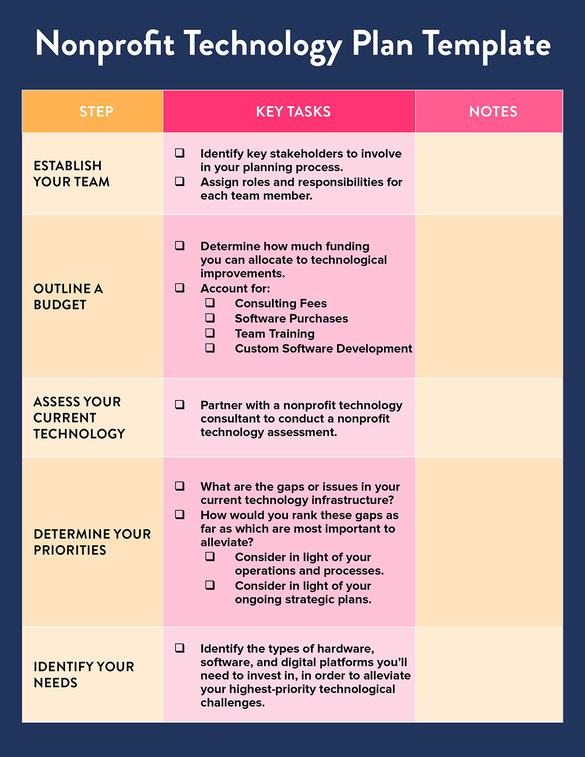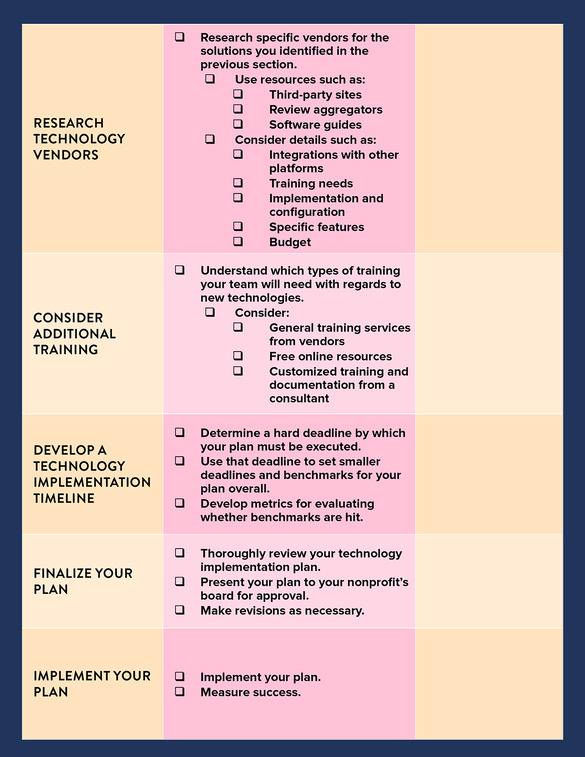Technology impacts many areas of your nonprofit’s operations, from donor management to fundraising, accounting, marketing, and more. It’s crucial to approach new purchases, investments, customizations, and other technology-driven projects with a conscious strategy.
A nonprofit technology plan gives your team this foundational infrastructure, allowing you to approach any technology overhauls with a clear strategy in place.
At DNL OmniMedia, we specialize in Digital Nonprofit Leadership. We offer full-service technology consultation to nonprofit organizations of all shapes and sizes, and we put a special emphasis on the planning process.
In this guide, we’ll cover the process of creating a nonprofit technology plan from start to finish through the following points:
- Nonprofit Technology Plan: The Basics
- Creating a Nonprofit Technology Plan in 10 Steps
- Technology Plan Template: Free Resource for Nonprofits
- How can a consultant help with your nonprofit technology plan?
Want to learn more about our nonprofit technology planning process and the best practices we recommend to clients? Let’s get started.
Nonprofit Technology Plan: The Basics
How does technology help nonprofit organizations?
Technology impacts nearly every aspect of modern nonprofit operations. This includes, but isn’t limited to, tasks such as:
- Coordinating internal and external efforts.
- Receiving donations.
- Conducting advocacy efforts.
- Managing data about supporters.
- Communicating with supporters.
- Hosting events.
Nonprofit organizations were able to complete all of the above tasks via analog methods prior to the development of much of the nonprofit technology that organizations utilize today. Nonprofit technology allows these organizations to not only complete these tasks, but do so more efficiently and in a way that frees up capacity across their teams.
What is a nonprofit technology plan?
A nonprofit technology plan is a strategically-developed blueprint for how your organization will use and invest in technology going forward.
This plan should encompass all technology and digital platforms that support your nonprofit’s work, providing a:
- Strategy for using your existing technology in smarter ways.
- Roadmap or schedule for making planned upgrades or new purchases.
- Contingency plan for unexpected technical emergencies or failures.
Most often, organizations develop technology plans when they’re in the market for new solutions, with the plan providing a structured approach to the research and purchasing process. However, a well-developed nonprofit technology plan should also cover how you’ll implement, use, and update any tools that you’ve purchased going forward.
Why do you need a nonprofit technology plan?
There are two major reasons to develop a nonprofit technology plan prior to making any major changes to your organization’s technology stack.
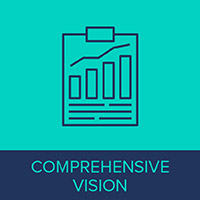
First, an effective plan enables your organization to develop a more comprehensive technology strategy. Many nonprofits unintentionally build shaky technology foundations as a result of investing in platforms or tools on an ad-hoc basis, implementing short-term solutions for long-term problems. A nonprofit technology plan guides your organization to take a comprehensive, big-picture approach to your long-term technology needs and goals.

Further, a nonprofit technology plan can provide your organization with a renewed focus that you may have been lacking previously. This plan will help your team as a whole understand your long-term strategies and goals and the steps you’ll need to take from a technology standpoint to accomplish them. You’ll have a timeline for scheduled updates and custom development projects as well as a plan for handling tech emergencies. It will prevent stress and wasteful spending and allow your team to work in unison toward your goals.
What types of technology do nonprofits use?
Nonprofits use a variety of platforms to support their operations, engage supporters, and advance their missions. While each organization’s toolkit configurations will vary, here are some common types of technology that nonprofits frequently use:
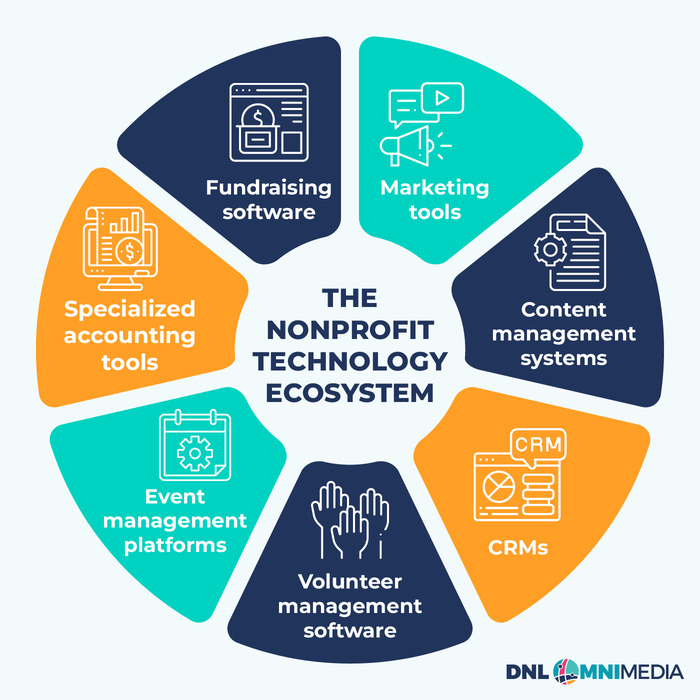
- Fundraising software includes tools for donations, corporate giving facilitation, donor databases, and peer-to-peer giving. This technology enables nonprofits to accept online donations, manage donor relationships, launch fundraisers, and more.
- Marketing tools help organizations create email campaigns, schedule social media posts, view user engagement metrics, and more.
- Content management systems help nonprofits design websites so they can establish their online presence, share mission information, and promote involvement opportunities.
- CRM systems help nonprofits track and manage interactions with donors, volunteers, and other stakeholders. They enable personalized communication and donor engagement.
- Volunteer management software enables nonprofits to recruit, schedule, and coordinate volunteers for various activities and events.
- Event management software helps nonprofits plan and promote fundraising events, conferences, and workshops. It typically includes features for registration, marketing, ticketing, and livestreaming.
- Specialized accounting software enables organizations to manage their finances and meet compliance requirements.
Of course, there are other other solutions out there you might need. Best of all, many of these tools can also integrate with businesses’ corporate social responsibility (CSR) software to facilitate volunteer activities, simplify matching gift management, accept company donations, and tap into all sorts of corporate giving initiatives.
Creating a Nonprofit Technology Plan in 10 Steps
If creating a new technology plan for your nonprofit sounds like a smart move, you’re probably excited to get started. However, it’s important to take a systematic approach when developing any new strategy— including your nonprofit technology plan.
We’re going to discuss the process of creating a nonprofit technology plan in 10 steps:
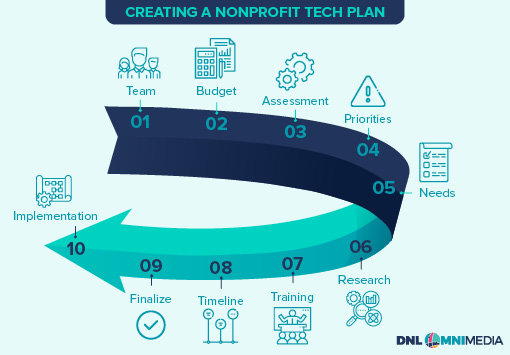
- Establish your team.
- Outline a budget.
- Assess your current technology.
- Determine your priorities.
- Identify your needs.
- Research technology vendors.
- Consider additional training.
- Develop a technology implementation timeline.
- Finalize your plan.
- Implement your plan.
Now, let’s discuss each step in greater detail.

Step 1: Establish your team.
Begin the process by assembling your team, which should include a wide range of stakeholders beyond just the team members who will be directly interacting with your technology.
Involving a range of stakeholders ensures their unique perspectives are incorporated into your plan, so all stakeholder needs are identified and prioritized. While the size of your technology planning committee will vary depending on the size of your organization and its goals, it will likely incorporate members from the following groups:

- Your nonprofit’s staff, specifically with regards to staff members who will be using any new solutions you adopt.
- Your nonprofit’s board, such as one or two members and your executive director.
- Other stakeholders, such as major donors, long-term volunteers, or community stakeholders.
Beyond representatives from your nonprofit, you’ll also likely want an external nonprofit technology consultant as a part of this team. A third party can quickly identify problem areas that might be in your team’s blind spots. Their own experience and insights will give you a big-picture strategy for the long run in a way a purely internal team might not be able to.
Start by developing a responsible party list that documents each individual’s key roles. Your tech planning team should represent diverse perspectives but also have clearly defined roles and responsibilities for each member.

Step 2: Outline a budget.
Your organization has a finite amount of funding that you can reasonably allocate to internal technological improvements. Outline a general budget that encompasses how much you can reasonably spend on the process of developing and implementing your nonprofit technology plan before you proceed any further in the process.
Outlining this general budget upfront ensures that you’re mapping out a plan that your team can actually execute from the start, rather than a dream scenario that’s simply impossible with your current funding. This can also help you gain approval from your nonprofit’s board, which will likely need to approve any significant spending made throughout the process.
Generally, the costs of developing and implementing your nonprofit technology plan could include:
- Consulting fees, including fees associated with developing the plan (such as conducting a technology assessment) and executing it (such as implementing new technology, conducting team training, and more)
- Software purchases and any costs associated with implementing those technologies, such as data migration
- Team training, which includes the cost of both the team member time used to partake in training and any outside experts that you work with from an instructional standpoint
- Custom software development, whether that means fully building a custom solution from scratch or even customizing an existing solution (like your organization’s constituent relationship management solution)
Later in the process of developing your nonprofit technology plan, you will research technology solutions and vendors to alleviate the gaps in your tech strategy. At that point, you’ll closely examine each prospective solution that you might acquire from a budgetary standpoint, to understand the short- and long-term costs associated with each tool. At this point, however, your goal is to understand your organization’s overall budget for the project.

Step 3: Assess your current technology.
The next step is to compile a comprehensive inventory of your nonprofit’s current software and hardware. The goal is to understand which solutions you’re currently using and how well they perform with the following questions in mind:
- What works well? What do we do well with our technology?
- What aspects of our tech operations need improvement?
- Are there any chronic pain points in our tech infrastructure?
- Do we have any tech assets that we can stand to lose? Are there any that we want or need to replace?
- Are there any tech assets that need repairing, and how feasible are those repairs?
- Which assets can be improved, and what improvements or integrations would that entail?
We recommend conducting a comprehensive nonprofit technology assessment with the help of your consulting partner. This DNL OmniMedia guide breaks down the steps that a consultant will take to assess your technology, as follows:
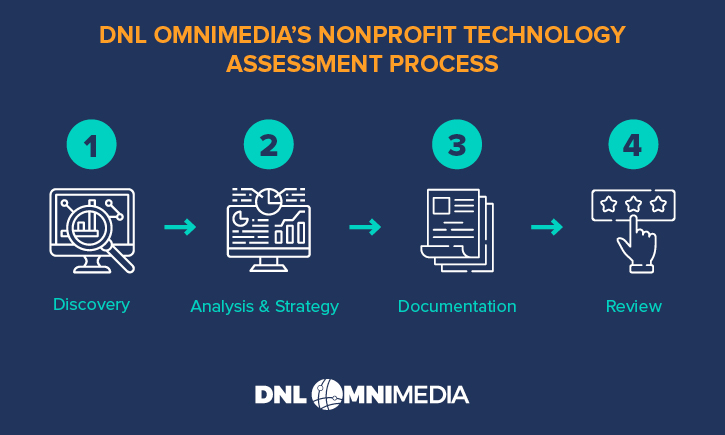
- Discovery: The consultant syncs with your team to develop an understanding of your goals and current technology use.
- Analysis & Strategy: The consultant conducts an analysis of your current software and formulates a strategy to align those solutions with your goals.
- Documentation: The consultant documents their recommendations.
- Review: The consultant reviews their recommendations with your team and discusses next steps.
In total, this process can take anywhere from six to 12 weeks from start to finish. That said, while it can be a time-consuming process, it’s worthwhile to have a comprehensive understanding of your technology before proceeding any further with planning your strategy.

Step 4: Determine your priorities.
Review the schematic or roadmap that your team developed in the previous step, specifically noting the high points, low points, and areas for improvement across your organization’s current technology.
Use this information to further narrow down the most important priorities to address in your nonprofit technology plan, considering both short- and long-term goals. Consider the following when clarifying your most pressing technological priorities:
- Identify gaps and issues in your current technology infrastructure using the assessment you completed. Use a ranking system to assign importance to various pain points and areas for improvements in your current tech.
- Consider your operations and processes. How does your team use technology on a daily basis? What roles does technology play in your marketing and fundraising campaigns?
- Review your ongoing strategic plans. This includes capital campaigns, other development projects, or major marketing campaigns. Your tech goals need to align with (and contribute to) the bigger picture guiding your organization.
Take the time to consider your technology goals from 360 degrees. While an immediate need most likely spurred your team to develop a nonprofit technology plan to begin with, your comprehensive assessment may have unveiled additional opportunities for improvement. This step allows you to prioritize these improvements to address the most pressing matters first.

Step 5: Identify your needs.
Review the priorities that you’ve established and write out the specific types of hardware, software, or other digital platforms that you’ll need to acquire in order to reach your goals. Many organizations develop new technology plans around the need to replace one of their central tools. If your nonprofit technology plan is also built around a specific need, start there.
You’ll research different options and vendors later, but for now, focus on defining the scope of your needs and the specific types of technology that you’ll need. A consultant who’s assessed your tech infrastructure in the previous steps will be able to quickly outline and prioritize any issues that require addressing.
For instance, replacing an entire CRM or database platform is a much larger-scale goal than adopting and integrating a single new piece of fundraising software. Consider how your team broke down its goals into short- and long-term categories, and try to focus on more major updates and replacements first. They’ll be the foundation on which to build the rest of your nonprofit technology plan as you put it into action.

Step 6: Research technology vendors.
Begin filling out the framework of your nonprofit technology plan by researching vendors and tools that will address the priorities you’ve established.
Identify software vendors that offer scalable packages and support services, as this will allow you to customize your experience with the vendor to meet your organization’s exact needs. Research top providers online using third-party sites, review aggregators, and educational guides.
There is a wealth of information available online for nonprofits that are looking to vet potential software solutions. As just one example, organizations interested in enterprise-sized CRM software can find all of the following guides on the DNL OmniMedia blog:
- Salesforce Nonprofit Success Pack: the Complete Guide
- CRM Software: the Guide to Blackbaud Solutions
- EveryAction Guide
If you’re working with a nonprofit technology consultant, draw on their expertise at this point in the process. You’ll want to consider all of the following when evaluating technology solutions:
- Any integrations with other platforms that you want or need
- Your team’s need and budget for training services
- Your organization’s ability to configure and implement each solution
- Specific or unique features that you’ll want or need
Additionally, you’ll want to consider solutions in terms of both immediate and future budgetary impacts. New tools are important investments for nonprofits, so take your time choosing the perfect partners!

Step 7: Consider additional training.
Ensure your team is trained to use all newly implemented solutions. Some platforms and tools are more difficult to learn than others, and your organization’s level of experience with tools at that scale will impact the learning curve. Different types of nonprofit tech training include:
- General training services from software vendors
- Free online training resources for less intensive tools
- Customized training and process documentation services from a nonprofit technology consultant
For simpler software solutions, a staff member who’s more familiar with the platform can often train any others who will need to use it. For more major investments or for platforms that will be central to your operations (like a CRM, comprehensive fundraising platform, or accounting software), it’s wise to devote time and/or money to additional training from a technology professional.
If you’re working with a consultant to develop your technology plan, they can recommend best practices in terms of tech training. At Team DNL, for instance, we make sure to carefully document every step in the process and develop training next steps.

Step 8: Develop a technology implementation timeline.
After selecting vendors for your key tech investments, your team should outline a timeline for your tech projects. The best way to start is by determining a hard deadline. When does the core short-term goal of your technology plan need to be completed?
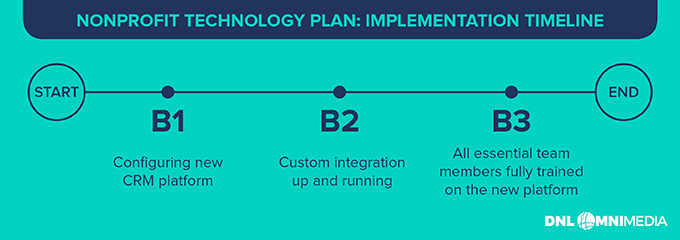
From there, follow this general process to build an implementation timeline around that deadline:
- Determine a hard end date that you want your short-term goal, like having a new CRM platform up and running, completed by.
- Set benchmark points at regular periods between the deadline and the start date.
- Define specific benchmark goals or tasks that need to be completed before or at each benchmark point. Examples might include finalizing the configuration of your new CRM, training key staff, or having a crucial integration up and running.
- Develop methods for evaluating the success of each benchmark goal.
Remember, it’s impossible to accurately gauge your successes without a concrete method for measuring them. It’s very easy for your technology plans to slow down or derail completely when there’s no pre-defined way to recognize problems as they arise.
With a dedicated implementation timeline in place, you can foster accountability and quickly determine next steps should any slowdowns occur.

Step 9: Finalize your plan.
If you’ve taken your time working through the previous steps, your technology plan should begin taking a concrete shape. Let’s quickly review the key elements it should contain:
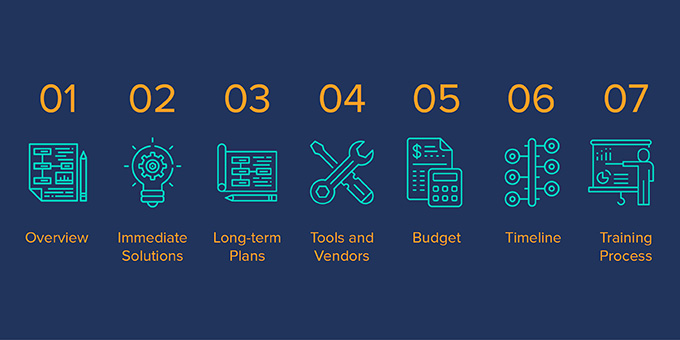
- An overview of your existing tech infrastructure.
- Solutions to your immediate, short-term technology issues.
- Long-term plans for how your new solutions will be implemented into your larger toolkit and operations.
- A list of the platforms or software you’ll need to purchase, with chosen vendors when applicable.
- A budget for your nonprofit technology plans, including total cost of ownership analyses.
- An implementation timeline, including scheduled benchmarks and methods of evaluation.
- An outline of the training process or services for implementing your nonprofit tech plan.
Take the time to thoroughly review every element with your core team. Once you’re happy with the results, present your nonprofit technology plan to your entire board for approval. It can sometimes take multiple rounds of review and edits, particularly around budgeting and timeline logistics, to reach a finalized plan, so be prepared to tinker with it.
At DNL OmniMedia, we include up to three full rounds of review and revisions in our tech plan development process. Creating a comprehensive technology roadmap entails a lot, so it’s very important that your plans check all the boxes for your organization.

Step 10: Implement your plan.
Once your organization’s board has approved your nonprofit technology plan, it’s time to begin implementing it.
At this point, and with a finalized technology plan in hand, some nonprofits will begin the process of applying for grants. If your organization could use some extra support in putting your tech plans into action, research grant-giving institutions and foundations that focus on supporting nonprofit development in your community or around your mission.
Congratulations on creating a nonprofit technology plan! All your hard work will pay off as your tech plans come together to support your organization’s continued growth.
Technology Plan Template: Free Resource for Nonprofits
As you now know, creating an effective, foundational nonprofit technology plan requires multiple steps. We’ve condensed everything into a template so you can check off the boxes as you complete each step:
Be sure to download this free template, so you can complete each step and keep your team on track throughout the process.
Wrapping Up: How can a consultant help with your nonprofit technology plan?
A nonprofit consultant can assist with the development and implementation of your nonprofit technology plan in numerous ways, including:
- Technology assessments and audits. A consultant can conduct a comprehensive technology audit for your organization before you start developing a plan.
- Strategy development. A tech consultant can review your technology and recommend immediate next steps and long-term goals for your organization.
- Vendor research and recommendations. Technology consultants are knowledgeable about the nonprofit tech space and can quickly point you to the most effective and scale-appropriate solutions.
- Comprehensive training. For the best results down the line, have a consultant train your team on how to use any new tools you adopt as part of your strategic plan.
- Custom technology services. A tech consultant can provide fully customized implementation, configuration, and development services. This can be invaluable for large-scale platforms that require complex integrations or in the run-up to major digital campaigns.
The right technology partner can guide you through the entire technology planning process. Their insights into all the offerings on the market, technical skills, and experience working with other organizations of all sizes can ensure that your tech plan is realistic, achievable, and sustainable.
Team DNL is composed of Digital Nonprofit Experts. We focus on developing comprehensive and actionable technology plans for every project we undertake. To learn more about how DNL OmniMedia can assist with developing your nonprofit technology plan, contact our team today.
In the meantime, continue your research with the following additional resources:
- Nonprofit Technology Assessment: Evaluate Your Tech. One crucial part of creating a nonprofit technology plan is conducting a technology assessment. Review the process in this guide.
- Nonprofit Consulting Firms: 26 Leaders in Their Spaces. There’s a high likelihood that your team will want to work with a nonprofit consulting partner to develop your plan. Explore top consulting partners in this guide.
- Nonprofit Technology: Why, What & How of Smarter Fundraising. Are you unsure of which solutions you need to invest in, and why? Explore this comprehensive guide to nonprofit technology.



